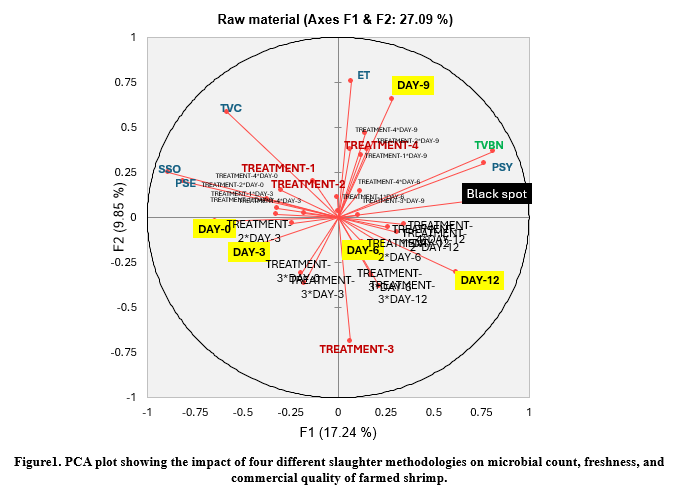MICROBIAL INFLUENCE ON BLACK SPOT DISEASE IN FARMED SHRIMP: THE ROLE OF BIOFLOC SYSTEMS IN MITIGATION
Introduction
Shrimps are one among the most traded species around the world. In the world, ( L. vannamei) is the most desired species for cultivation owing to several advantages over other species (FAO, 2014). As in the case of any food product, spoilage in shrimps is a major concern for shrimp farmers and shrimp processing industry. The shrimp are a highly perishable product due to their rapid microbiological and biochemical spoilage post-harvest. Black spot (melanosis) is a common post-harvest defect in farmed shrimp, characterized by dark pigmentation on the shell due to enzymatic oxidation. In biofloc production systems, which enhance water quality and shrimp immunity through microbial floc, the occurrence of black spot may be influenced by factors such as water composition, stress during harvest, and microbial dynamics. While biofloc offer improved health and growth performance, their impact on post-harvest quality, including melanosis susceptibility, remains a critical area for optimization in commercial shrimp farming. The primary objective of this study is to evaluate the impact of microbial dynamics on the development of black spot disease in farmed shrimp during ice storage, while comparing different slaughter methods and investigating the potential of biofloc systems to mitigate the disease over time.
Material and Methods
Four slaughter methods were evaluated: cold thermal shock (TS) using refrigerated seawater (-2ºC) (TREATMENT-2 -Control-) (TS was implemented in all slaughter methods); 5 min immersion in refrigerated seawater (0±2.5 ºC) with 50 ppm bleach followed by TS (TREATMENT-1) ; clarification (3–4 h) before 50 ppm bleach (TREATMENT-3 ) and TS; and TS followed by 2 min UV exposure in each side of the shrimp (TREATMENT 4). A trained sensory assessor’s panel evaluated the melanosis progression, over 7 days on interval of 48 h, using the procedure “Melanosis Score Sheet” described in Montero et al (2001). Additionally, bacterial specific study (Specific Spoilage Organism -SSO- , Total Viable Count -TVC-, Pseudomonas -PSE-, Enterobacteria -ET- and Psychotropics -PST- ) was carried out, together with a physicochemical parameter (non-protein nitrogen-TVB-N) . The data collected were analysed using XLSTAT® statistical software, performing descriptive analysis, panel analysis, ANOVA and Fisher’s post hoc tests. The results were presented using a Principal Component Analysis (PCA) as a general test.
Results and dicussion
The PCA analysis (Fig.1) of fresh shrimp stored on ice reveals critical insights into spoilage progression and the effectiveness of four different treatments. Microbiological indicators such as Specific Spoilage Organisms (SSO), Pseudomonas (PSE), and Total Viable Count (TVC) are closely grouped on the left side of the plot, correlating with early spoilage and associating with samples from DAY-0 and DAY-3. These early-stage samples also align with TREATMENT-1 and TREATMENT-2, suggesting these treatments are effective at preserving microbial quality in the initial storage period. In contrast, spoilage parameters like Enterobacter (ET), Psychrotrophics (PSY), Total Volatile Basic Nitrogen (TVBN), and black spot development point toward the right and lower quadrants of the plot, indicating their relevance in advanced spoilage. DAY-9 and especially DAY-12 are positioned along these spoilage vectors, highlighting a significant decline in quality over time. Notably, TREATMENT-3 clusters near DAY-12 and the black spot vector, indicating it was the least effective in controlling spoilage and melanosis. TREATMENT-4 shows moderate performance, with some overlap toward spoilage indicators. Overall, this analysis shows that TREATMENTS 1 and 2 provide the best preservation of shrimp quality, particularly within the first nine days of storage, while TREATMENT-3 fails to mitigate spoilage effectively.
Conclusions
The study clearly demonstrates the critical influence of slaughter methods on the microbiological quality and shelf-life stability of ice-stored shrimp, from biofloc production system with melanosis (black spot) emerging as a key quality-degrading factor impacting commercial value. Among the evaluated approaches, TREATMENT-1—involving immersion in refrigerated seawater (0 ± 2.5 ºC) with 50 ppm sodium hypochlorite followed by cold thermal shock (TS)—proved the most effective, showing strong correlations with suppressed microbial loads (TVC, SSO, PSY), lower TVBN levels, and significantly delayed black spot development, particularly up to DAY-9. TREATMENT-2 (TS alone, used as control) also maintained acceptable microbial quality but was slightly less effective in controlling melanosis, which can negatively affect consumer acceptance and marketability. In contrast, TREATMENT-3 (clarification followed by bleach and TS) resulted in elevated spoilage indicators and pronounced black spot formation by DAY-12, rendering it commercially unviable. TREATMENT-4 (TS followed by UV exposure) showed intermediate performance, with no substantial advantage over the control. From a commercial perspective, TREATMENT-1 is strongly recommended for ice-storage operations targeting extended shelf life and high sensory quality, particularly for export markets where appearance is critical. It is further recommended that shrimp be marketed or processed by DAY-6 to DAY-9, and that regular monitoring of melanosis and microbial indices be implemented to ensure product integrity, reduce losses, and meet regulatory and customer expectations.
Acknowledgments
This work was supported by I+D+i Research Project: “Pursuing the zero waste in Biofloc Technology to produce a sustainable and biosafe aquaculture product (ZeroFloc )” (PID2023-149570OB-I00). S.Ferrando -Juan has a predoctoral Research Personnel Training Grant (PRE2021-098367); supported by MCIN/ AEI/10.13039/501100011033/. J. Gómez-Aguilera contract was supported by European Union Next Generation -Plan of Conselleria d’innovació , Universitats , Ciència i Societat Digital of Generalitat Valenciana (INVEST/2022/434).
Bibliograhy
Qian Hong et al. (2024) https://doi.org/10.1016/j.foodchem.2023.137258.
Montero et al. (2004) DOI: 10.1111/j.1365-2621. 2004.tb09913.x
Yan et al (2020) DOI: 10.1080/10498850.2020.1799470
